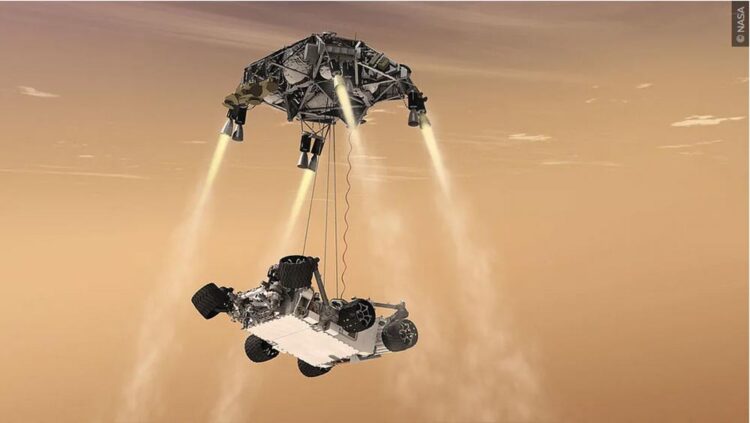Could Clay Buildings on Mars Become a Reality?

The Mars Rover Perseverance is set down with a special transport device.
(c) NASA
TU scientists are studying clay minerals found on the Red Planet
On 18 February 2021, the Mars 2020 Mission will finally land on the Red Planet. The Mars Perseverance Rover is scheduled to touch down at Jezero Crater, a large crater which scientists believe was once a lake. If there ever was any life on Mars, proof could be found here due to the previous habitable conditions provided by the water.
The rover will pursue a number of scientific objectives, including looking for signs of previous habitability. On the basis of satellite observations of the planet, we already know that the crater contains high levels of clay minerals, just as on Earth. Such clay minerals have been the focus of research for many years at TU Berlin’s Chair of Advanced Ceramic Materials, led by Professor Dr. Aleksander Gurlo.
Construction materials for potential stationing on Mars
In a number of publications, researchers at the academic chair provide evidence that these minerals not only lend themselves to making earthenware utensils from fired ceramics but also to constructing entire buildings. “Due to its remoteness from Earth, human exploration, permanent stationing or even the inhabitation of Mars will only be possible through the use of local resources – a practice referred to as in situ resource utilization,” explains David Karl, a research associate in Gurlo’s team. In addition to energy, water, oxygen, and food, construction materials are a basic necessity for potential stationing on Mars and are among those materials most difficult to transport to the planet.
“When compared to the construction materials used throughout the history of human civilization on Earth, the lack of organic materials such as plants presents a significant challenge. The only solid building materials available for early in situ resource utilization on Mars are regolith and rock. In our most recent publications we were able to demonstrate that the minerals on Mars, such as felsic rock, can transform into phyllosilicates (clay minerals) in the presence of water,” Karl continues.
Satellite images of Mars’ surface clearly indicate that the Jezero Crater, among other places, contains an abundance of different clay minerals. The scientists believe that these clay materials can be transformed into green bodies – wet, unfired ceramic objects – through the addition of water alone. “These green bodies can then be used to create stable objects for daily use, such as plates, vases and the like as well as clay bricks. Mars’ arid environment means these bricks are more stable than they otherwise would be. We have already been able to successfully demonstrate this in our experiments, where we shaped and produced such objects through 3D printing. Unfired clay bricks have been used in building for centuries by people in especially dry regions of the Earth such as in Shibam, Yemen, where an entire city was built of unfired clay, the tallest buildings rising 30 meters into the air,” says Karl.
Research processes under Martian conditions
The TU Berlin researchers hope to have tapped into a new resource for future research on in situ resource utilization (ISRU). In their publications, the researchers successfully demonstrate that their material system can easily be adapted to fit all shaping routes for the production of green bodies or fired ceramics, thus making the system ideal for the construction of simple dwellings or functional objects on Mars.
Currently, the researchers are working to establish the entire 3D-printing process using these clay minerals under simulated Martian conditions. The first measurements taken by the Perseverance Rover could help them to further optimize the clay composition of their materials. Their ultimate aim is to support scientific research about Mars using this clay-based material system.
Further information:
https://doi.org/10.1016/j.oceram.2020.100008
https://doi.org/10.1016/j.actaastro.2020.04.064
Further information can be obtained from:
Prof. Dr. Aleksander Gurlo
TU Berlin
Fachgebiet Keramische Werkstoffe
Tel.: 030 314-22368
E-Mail: gurlo@ceramics.tu-berlin.de
David Karl
TU Berlin
Fachgebiet Keramische Werkstoffe
Tel.: 030 314-23425
E-Mail: david.karl@ceramics.tu-berlin.de
Media Contact
All latest news from the category: Architecture and Construction
Newest articles

Pinpointing hydrogen isotopes in titanium hydride nanofilms
Although it is the smallest and lightest atom, hydrogen can have a big impact by infiltrating other materials and affecting their properties, such as superconductivity and metal-insulator-transitions. Now, researchers from…

A new way of entangling light and sound
For a wide variety of emerging quantum technologies, such as secure quantum communications and quantum computing, quantum entanglement is a prerequisite. Scientists at the Max-Planck-Institute for the Science of Light…

Telescope for NASA’s Roman Mission complete, delivered to Goddard
NASA’s Nancy Grace Roman Space Telescope is one giant step closer to unlocking the mysteries of the universe. The mission has now received its final major delivery: the Optical Telescope…



